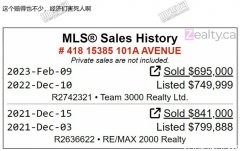加拿大华人论坛 加拿大房产雨季就要来了,LEAKY CONDO...
在加拿大
好像没有类似的帖子总结VANCOUVER的LEAKY CONDO。如果有这样一个BLACKLIST,应该会对找房者是个帮助吧?毕竟这是只有BC而且是1921-1999这一时段才有的特点。 请问有什么网站或者链接有这方面的总结吗?
评论
回复: 雨季就要来了,LEAKY CONDO...Re-Sale of Leaky Condos: Did the Buyer Know? Introduction British Columbia’s Homeowner Protection Office believes there is a total of about 65,000 dwellings in the province that are "leaky condos". As of 2002, 50,000 of them had been identified. "Leaky condo syndrome" is defined as catastrophic failure of the building envelope allowing water to enter the envelope and leading to rot, rust, decay and mold. The syndrome has affected condominiums, detached homes, schools and hospitals. Until the collapse of BC’s New Home Warranty Program in 1998, many real estate agents and others believed that the warranty company would repair most building envelope failures. However, only a small percentage of problems were resolved by the warranty provider. The leaky condo crisis has been exacerbated by the sale of problem homes without full disclosure to subsequent buyers. This has occurred despite the fact that it has been customary for real estate agents to include standard clauses, recommended by the Real Estate Council of BC, in a Contract of Purchase and Sale mandating the use of investigative tools and declarations to bring maximum transparency to transactions. The impact on people’s lives has been enormous, even horrendous in some cases. Some people have lost much or all of their life savings, even their homes. Family life, home-based businesses and health have suffered due to disruption and the mess during repairs, and the strain of it all.A real estate researcher and licenced agent, Nancy Bain, conducted a study in 2002 to determine why home buyers of re-sale leaky condos were not aware of problems when they made their purchase. The intent of the research was to facilitate improvements in increasing the transparency of transactions. Three possibilities were examined:The clauses mandating the use of investigative tools and declarations, to ensure disclosure, are not being included in contracts.The investigative tools are ineffective.The buyer did not understand the implications of the information provided.A selection criterion was that, within one year of purchase, the buyer discovered a material problem that had not been revealed at the time of purchase. Problem free transactions were not eligible for the study and the extent of problem transactions in the re-sale market was not examined. The researcher examined 40 transactions meeting this criterion. Of the 40, 20 were from Vancouver Island, and 20 were from Greater Vancouver and Fraser Valley. The transactions took place over a seven-year period, from 1996 to 2002 inclusive. The sample group proved to be ‘information rich’, providing valuable insight on the questions posed by this research. However, the sample group does not represent the population of all failed transactions during the period studied. For example, two key groups of buyers not represented are those for whom English is not their first language and investors. Sample group Candidates were sought who met the following criteria:They had purchased a condominium in the coastal climate area of BC (Greater Vancouver, the Fraser Valley or Vancouver Island)The purchase occurred in the period 1996 to 2002 inclusive.The unit was not new at the time of purchase.Within one year of purchase, the buyer discovered a serious problem that was not known at the time of purchase.Candidates had their documents of purchase and were willing to share them with the researcher.The type of serious problem was not pre-defined, but in every instance, those selected had purchased a unit with building envelope problems. The requirement that a serious problem be discovered within one year of purchase made it almost certain that the problem existed at the time of purchase. The majority of buyers 27 of the 40, or almost threequarters were aged 40 to 70.The same number had previously owned a detached home or a condominium, 11 had rented and two had lived in co-op housing. Half identified affordability as their main reason for buying a re-sale condominium. Four purposely bought re-sale condominiums to avoid the leaky condo problem, believing that an older building was less likely to have undetected problems. The majority (33) had heard of the leaky condo phenomenon before they purchased, but they were not familiar with the extent of the problem. Most of the remaining seven who had not heard of the problem were from Alberta. The majority of special assessments levied, which fund the cost of major repairs, ranged from about $25,000 to $60,000. Two assessments were much higher, with one at about $150,000 and the other just over $200,000. Such levies drastically affect people’s lives and cause financial hardship, and even ruin for some. The following were among the reasons given for arriving at a purchase decision:Some clues were believed to be normal maintenance items that would be resolved.Some buyers were told a problem had been fixed. Most home buyers are not aware of the high rate of failure of ‘fixes.’Some believed that concrete buildings or townhouses were not subject to the leaky condo syndrome.Some believed they had an accurate estimate of repair costs at the time of purchase, and they negotiated a price to reflect that cost.Some believed the investigative tools would give them clear answers, not just hints. They interpreted couched language to mean there was no serious problem.As to whether, in hindsight, the buyers thought there were any clues that a problem existed at the time of purchase, 24 said no. While four said there were signs in the strata corporation minutes, they did not have the minutes at the time of purchase. Three believed, after the fact, that certain design elements gave clues.Another three said there were physical clues but these had not been properly disclosed: they were otherwise explained away, hidden by furniture or not detected by a property inspector but readily apparent to a carpet cleaner. Findings Investigative tools The investigative tools used in a BC condominium purchase to bring transparency to the transaction include:a Property Disclosure Statementan inspection by a professional property inspectorminutes of strata corporation meetingssince July 2000, a Form B Information Certificatean engineering report.Since 1999, contracts have more consistently required use of investigative tools. Still, there are buyers who discover serious problems within one year of purchase. Property disclosure statement Of all the investigative tools, the Property Disclosure Statement (PDS) was used the most frequently. Its purpose is to disclose hidden or latent defects known to the seller. Although the PDS should have identified problems in a number of cases, it failed to do so. This tool cannot and should not be solely relied on for a number of reasons:In one BC court case, strata minutes revealed water ingress problems, but the sellers had answered ‘no’ to questions on the PDS about roof leakage and damages, structural problems and damage due to wind, fire or water. The judge decided that, since the minutes revealed water ingress problems, the buyer had failed to act in a reasonable manner by relying only on the PDS and denied a claim for damages.While new information about the physical condition of a property may emerge prior to completing a transaction, sellers rarely amend the PDS, despite the fact that the Statement requires them to do so.The seller and/or buyer may not understand the meaning of some of the questions as evidenced by the contradictions discovered.Professional Property InspectionsThis tool was used the least. Of the 40 cases, 29 did not have a property inspection, and none of the participants cited cost as the reason for not having one. It was found that the extent to which the exterior of a building is inspected varies greatly; the checklist format of the report sometimes buried significant information; and written comments by an inspector may appear benign but closer examination by a person knowledgeable about building envelope failure would reveal ominous warnings couched in soft language. Only one inspection report gave warnings in plain, simple language, which ensured the buyer understood the risk involved in purchasing. In eight cases, the reports should have caused alarm but they failed to do so. Minutes of strata meetingsThe minutes of a strata corporation and its strata council are considered an essential tool for a buyer in gaining insight on the knowledge and operations of the corporation. Half the contracts had a clause requesting minutes, although such a request did not appear as a standard clause until 1999. Prior to then, many BC real estate agents simply added this request to their contracts. In the more recent period from 1999 to 2002 inclusive, minutes were requested 13 out of 14 times, but there were challenges for the buyers to benefit from this information:Since 2000, the norm is to request 12 to 24 months of minutes, which in some cases is an onerous amount of material requiring careful reading within a limited period of time. As well, the minutes were often drafted in a manner that did not reveal the true condition of a building.Persons knowledgeable about building envelope failure may be able to discern certain ‘red flags’ in the minutes, but a typical home buyer has little chance of interpreting these signs.Form B Information CertificateSince July 2000, contracts have contained a request for a Form B Information Certificate. Its purpose is to disclose information about a strata corporation and the particular unit being purchased.The information disclosed is binding on a strata corporation in its dealings with a person who relies on the certificate. However, Form B is not revealing if a strata corporation has not taken any action to discover a serious problem, or to deal with known major problems.In this study, five sales qualified to receive a Form B, but only three had. However, the certificate did not alert the buyers to any problems because the need for major repairs had not yet been detected. Engineering reportsThe term ‘engineering report’, when associated with condominiums in the coastal climate area, is assumed to be an investigation of the building envelope. The credibility attached to these reports is very high.None of the contracts contained a request for an engineering report. However, in four cases, the buyers did receive information from engineering studies. In one case, the scope appears to have been limited, and the recommended repairs were a temporary measure, although this was not explicitly stated. In another case, a buyer received information extracted from an engineering report but not the entire report, which recommended a repair costing 400 per cent of what was suggested in the extract.Even if an engineering report is obtained, a buyer may not have sufficient knowledge to understand it. While some reports are straightforward, some have technicalities that would be detected only by a knowledgeable reader. Conclusions Conclusions are made on the sample of problem transactions studied. No conclusions, extrapolations or generalizations can be made about the extent to which there are problems with the investigative tools in the re-sale marketplace. All of the investigative tools have shortcomings, individually and collectively. In each instance investigated, a clear understanding of the risk was not apparent regardless of the tools used.Even if the use of investigative tools is more frequent, or if the leaky condo crisis has peaked, it is clear that there will still be many condominium buyers who discover, after the fact, that "what they got is not what they thought they bought." The tools are flawed, the contract can fail to require all the necessary documentation, and there is little assistance for buyers in understanding and analyzing the information they receive. Project Manager: Darrel R. Smith Research Consultant: Nancy Bain This project was funded (or partially funded) by Canada Mortgage and Housing Corporation (CMHC) under the terms of the External Research Program (ERP), an annual research grant competition.The views expressed are the personal views of the author(s) and do not represent the official views of CMHC. For more information on the ERP, please visit the CMHC Web site www.cmhc.ca or contact the Project Officer, Responsive Programs by e-mail at [email protected], or by regular mail: Project Officer, Responsive Programs, External Research Program, Policy and Research Division, Canada Mortgage and Housing Corporation, 700 Montreal Road, Ottawa ON K1A 0P7. Contact:Canada Mortgage and Housing Corporation700 Montreal RoadOttawa, OntarioK1A 0P7Phone: 1 800 668-2642Fax: 1 800 245-9274 Although this information product reflects housing experts' current knowledge, it is provided for general information purposes only. Any reliance or action taken based on the information, materials and techniques described are the responsibility of the user. Readers are advised to consult appropriate professional resources to determine what is safe and suitable in their particular case. CMHC assumes no responsibility for any consequence arising from use of the information, materials and techniques described. Princess
评论
回复: 雨季就要来了,LEAKY CONDO...也就是说,仔细看MINUTES,PDS,仔细验屋,应该就比较保险
评论
回复: 雨季就要来了,LEAKY CONDO...公主, 现在Burnaby Central Park 附近的矮层Condo, 1200多尺是否还好卖出?
评论
回复: 雨季就要来了,LEAKY CONDO...楼上的1200尺condo,请说明情况
评论
回复: 雨季就要来了,LEAKY CONDO...楼上的1200尺condo,请说明情况点击展开... 2 beds, 1 den, 2 baths, 5 minutes walk to skytrain and Central park. 3 level condos.
评论
回复: 雨季就要来了,LEAKY CONDO...给个具体点的,联系方式,价格等等
·加拿大新闻 看到快买加国Costco新晋爆款刷屏
·加拿大新闻 从追面子到享自我,宝马购车观转变
·加拿大新闻 每周连轴转80小时加拿大医生自爆行业黑幕
·加拿大新闻 万锦、Newmarket多家奶茶店/美甲店/理发店被指控+开罚单
·加拿大新闻 移民急刹车见效!加拿大人口首次出现历史性大幅下降
·中文新闻 一名男子因推动反犹太复国主义而在悉尼市议会市长的长篇大论
·园艺 蒜黄和蒜芽













